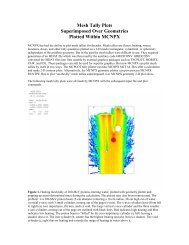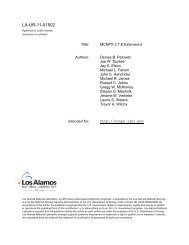MCNPX, VERSION 2.4.0 - MCNPx - Los Alamos National Laboratory
MCNPX, VERSION 2.4.0 - MCNPx - Los Alamos National Laboratory
MCNPX, VERSION 2.4.0 - MCNPx - Los Alamos National Laboratory
You also want an ePaper? Increase the reach of your titles
YUMPU automatically turns print PDFs into web optimized ePapers that Google loves.
LA-UR-02-5253<br />
FM2 (-1 102 18 1018)<br />
It is always wise to plot the desired cross sections first to see if they are available with<br />
the expected reaction numbers in the data library. The tally multipliers treat the data the<br />
same way as the data are treated in transport: the cross section at the lowest energy is<br />
extended down to E = 0 for protons with mt < 0; the cross section at the highest energy<br />
of the table is extended to E = ∞ for proton interaction cross sections with mt < 0 and for<br />
photonuclear interaction cross sections, mt < 1000. These extrapolations can be seen in<br />
the cross section plots.<br />
6.0. FUTURE WORK<br />
• Mix-and-match capability: In the neutron (and other particle) energy range<br />
above the top energy of some data libraries but below the top energy of other<br />
libraries, <strong>MCNPX</strong> currently cannot mix both model and tabular data. Either<br />
the higher-energy data are ignored and models are used for all nuclides or the<br />
data are used where they exist and are extrapolated from the top of the<br />
energy table for nuclides where the data do not exist. A means of mixing and<br />
matching both tabular data and model data is being developed.<br />
• CEM 2K: The current CEM physics model is being updated.<br />
• Pulse height tallies with variance reduction.<br />
• Cugnon Intranuclear Cascade (INC) model and Schmidt evaporation model.<br />
• Special features for Space applications.<br />
• A capability to continue runs that write HTAPE files<br />
• Integration of HTAPE tallies directly into <strong>MCNPX</strong>.<br />
• Heavy ion tracking and interactions.<br />
• Improved high energy physics with the LAQGSM model.<br />
7.0. ACKNOWLEDGEMENTS<br />
The principal developers of <strong>MCNPX</strong> <strong>2.4.0</strong> are John Hendricks, Gregg McKinney, Grady<br />
Hughes, Laurie Waters, Edward Snow, Skip Egdorf, Teresa Roberts, and Franz<br />
Gallmeier (ORNL). <strong>MCNPX</strong> <strong>2.4.0</strong> is based on <strong>MCNPX</strong> 2.3.0, MCNP4C3, Dick Prael’s<br />
LAHET code system, and Stepan Mashnik’s CEM code. <strong>MCNPX</strong> has benefited from<br />
many other developers over the years.<br />
Dr. Grady Hughes has been instrumental in the development of <strong>MCNPX</strong> since the<br />
program’s inception in 1995. The code has also greatly benefited from the work of the<br />
14




